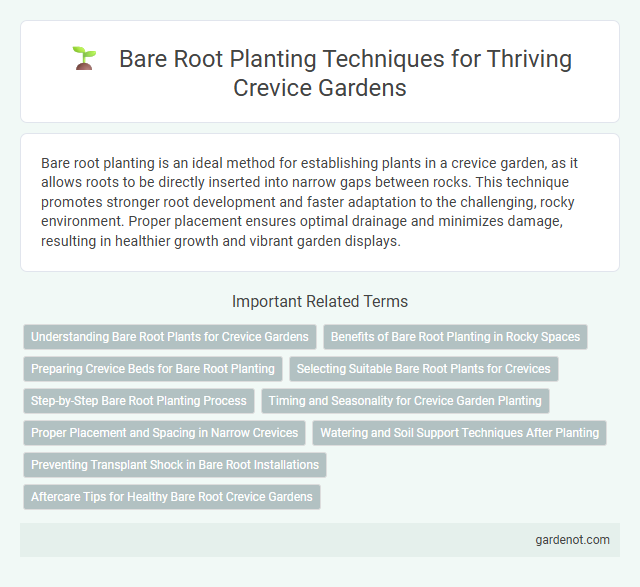Bare root planting is an ideal method for establishing plants in a crevice garden, as it allows roots to be directly inserted into narrow gaps between rocks. This technique promotes stronger root development and faster adaptation to the challenging, rocky environment. Proper placement ensures optimal drainage and minimizes damage, resulting in healthier growth and vibrant garden displays.
Understanding Bare Root Plants for Crevice Gardens
Bare root plants for crevice gardens offer a unique advantage by allowing direct root-to-soil contact, which promotes faster establishment and growth within narrow stone fissures. Understanding the dormancy phase of these plants is crucial, as they are typically planted before bud break to minimize transplant shock and maximize root system development. Proper soaking and careful handling during planting ensure healthy root expansion, supporting the long-term success of crevice garden designs.
Benefits of Bare Root Planting in Rocky Spaces
Bare root planting in crevice gardens offers significant benefits by promoting faster root establishment and improved adaptation to rocky, low-nutrient environments. This method reduces transplant shock and enables plants to efficiently anchor in narrow rock fissures, enhancing water absorption and stability. Utilizing bare root plants in rocky spaces also lowers shipping costs and allows for easier inspection of root health before planting.
Preparing Crevice Beds for Bare Root Planting
Preparing crevice beds for bare root planting involves thoroughly loosening the soil and incorporating well-draining, gritty materials like sharp sand and small gravel to replicate natural rock fissures. Ensure the bed has a deep, narrow cavity to accommodate the bare roots without bending or crowding, promoting strong root establishment. Accurate soil pH and moisture control are crucial to create an optimal environment for bare root plants to thrive in crevice gardens.
Selecting Suitable Bare Root Plants for Crevices
Selecting suitable bare root plants for crevice gardens requires prioritizing species with shallow root systems and high drought tolerance, such as Saxifraga, Lewisia, and Sedum. These plants naturally thrive in narrow, rocky spaces and can establish roots quickly in minimal soil, ensuring stability and growth in crevices. Proper selection promotes biodiversity, resilience, and aesthetic appeal in crevice garden environments.
Step-by-Step Bare Root Planting Process
Bare root planting in a crevice garden involves soaking the roots in water for several hours before planting to ensure hydration. Carefully position the plant's roots in the crevice, spreading them out to encourage growth, then backfill with a well-draining soil mix tailored for alpine plants. Firm the soil gently around the roots to eliminate air pockets and water thoroughly to settle the plant into its new environment.
Timing and Seasonality for Crevice Garden Planting
Bare root planting in crevice gardens is best executed during late winter to early spring when plants are dormant, maximizing root establishment and growth potential. Optimal timing aligns with soil temperatures above freezing, ensuring roots can access moisture and nutrients without stress. Seasonal conditions in early spring promote vigorous growth, critical for the success of delicate crevice garden species such as saxifrages and alpine plants.
Proper Placement and Spacing in Narrow Crevices
Bare root planting in crevice gardens requires precise placement to ensure roots have adequate contact with soil while avoiding overcrowding. Proper spacing between plants, typically 2 to 4 inches apart in narrow crevices, promotes healthy root expansion and prevents competition for nutrients. Maintaining these optimal distances enhances airflow and moisture retention, critical for plant vigor in restricted growing environments.
Watering and Soil Support Techniques After Planting
Water bare root plants immediately after planting to ensure deep soil moisture and promote root establishment in crevice gardens. Use well-draining, rocky soil mixtures with organic matter to provide sufficient aeration and stability for roots while retaining moisture. Regularly monitor soil moisture levels and water deeply but infrequently to encourage drought-resistant root growth in rocky crevice environments.
Preventing Transplant Shock in Bare Root Installations
Bare root planting in crevice gardens requires careful handling to prevent transplant shock by ensuring roots remain moist and undamaged during installation. Properly spacing plants within crevices allows for optimal root expansion and nutrient absorption, promoting quicker establishment and reduced stress. Using a root stimulator or applying mycorrhizal fungi can enhance root growth and improve plant resilience in these challenging microhabitats.
Aftercare Tips for Healthy Bare Root Crevice Gardens
Ensure consistent moisture by watering bare root plants immediately after planting and maintaining evenly moist soil during establishment to prevent drying out. Apply a layer of organic mulch around the crevice garden to retain soil moisture, regulate temperature, and suppress weeds that compete for nutrients. Monitor for pests and diseases regularly, trimming any damaged growth to promote healthy development and ensure optimal establishment in the crevice garden environment.
Bare root planting Infographic

 gardenot.com
gardenot.com